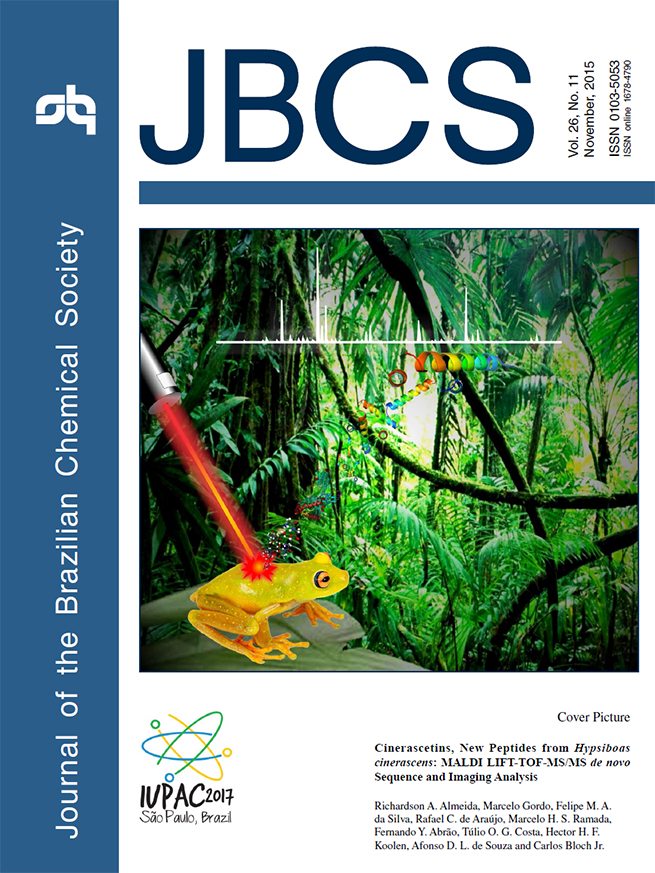vol. 26, No. 11, 2015, p. 2169-2388
Chemistry of Our Oceans
I believe that our planet should have been named Water, instead of Earth. Oceans cover most of the surface of our planet! In fact, Earth's oceans hold about 1.5 x 1018 tons of water, which in turn contains an enormous amount of dissolved salts. As a result, a lot of chemistry is taking place in the oceans.
Oceans play a central role in the climate of our planet; provide several ecological services such as food provision, energy, transport, nutrient cycling, and biodiversity, among others. Given the importance of the ocean for humankind, and the increase pressure they are under, it is timely to improve our knowledge and prioritize ocean issues that are covered in the chemical oceanography.
(Read more at Editorial)
Cinerascetins, New Peptides from Hypsiboas cinerascens: MALDI LIFT-TOF-MS/MS de novo Sequence and Imaging Analysis
Richardson A. Almeida; Marcelo Gordo; Felipe M. A. da Silva; Rafael C. de Araújo; Marcelo H. S. Ramada; Fernando Y. Abrao; Túlio O. G. Costa; Hector H. F. Koolen; Afonso D. L. de Souza; Carlos Bloch Jr
How to cite this article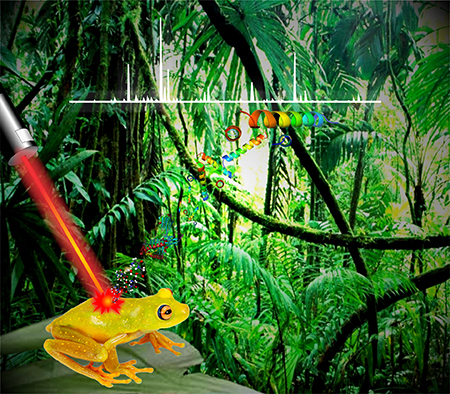
The number of antibiotic-resistant microbes increases each year, whereas the number of new antibiotics does not follow the same rate, encouraging different surveys focusing on new active substances. From an expedition into the Amazon Rain Forest different green-tree frog (Hypsiboas cinerascens) specimens were captured and chemically studied aiming the discovery of new antimicrobial substances. Details are presented in the Article Cinerascetins, New Peptides from Hypsiboas cinerascens: MALDI LIFT-TOF-MS/MS de novo Sequence and Imaging Analysis by Richardson A. Almeida, Marcelo Gordo, Felipe M. A. da Silva, Rafael C. de Araújo, Marcelo H. S. Ramada, Fernando Y. Abrao, Túlio O. G. Costa, Hector H. F. Koolen, Afonso D. L. de Souza and Carlos Bloch Jr. on page 2290.
https://dx.doi.org/10.5935/0103-5053.20150219
Editorial J. Braz. Chem. Soc. 2015, 26(11), 2169-2170
Communication J. Braz. Chem. Soc. 2015, 26(11), 2171-2174
Metal Oxide/Gold Hybrid Nanocomposites as Electrocatalysts for Alkaline Air Electrodes
Anielli M. Pasqualeti; Francisca E. R. Oliveira; Fabio H. B. Lima
How to cite this article

MnCo2O4/Au exhibited a synergistic effect boosting the oxygen reduction and evolution. In situ X-ray absorption near edge structure (XANES) revealed that MnIII-CoII play a role in the reduction. Au induced the increase in the CoIV amount, favoring the oxygen evolution.
https://dx.doi.org/10.5935/0103-5053.20150232
Review J. Braz. Chem. Soc. 2015, 26(11), 2175-2188
Zinc, Lithium and Magnesium Carbenoids: Chemical Properties and Relevant Applications in Organic Synthesis
Rodolfo H. V. Nishimura; Valter E. Murie; Rafael A. Soldi; Joao L. C. Lopes; Giuliano C. Clososki
How to cite this article
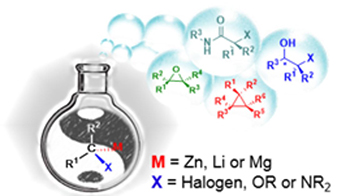
The ambiphilic character of carbenoids, represented by the chinese yin yang, shows how apparently opposite forces can be complementary in organic synthesis.
https://dx.doi.org/10.5935/0103-5053.20150218
Articles J. Braz. Chem. Soc. 2015, 26(11), 2189-2194
Volatile Organic Compounds from Filamentous Fungi: a Chemotaxonomic Tool of the Botryosphaeriaceae Family
Francisco C. Oliveira; Francisco G. Barbosa; Jair Mafezoli; Maria C. F. Oliveira; André L. M. Camelo; Elisane Longhinotti; Ari C. A. Lima; Marcos P. S. Câmara; Francisco J. T. Gonçalves; Francisco C. O. Freire
How to cite this article
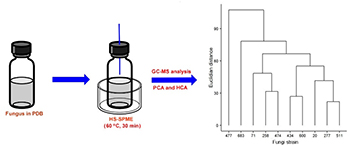
Volatile organic compounds from ten endophytic fungal species belonging to the Botryosphaeriaceae family were extracted by headspace-solid phase micro-extraction (HS-SPME) and analyzed by gas chromatography-mass spectrometry (GC-MS).
https://dx.doi.org/10.5935/0103-5053.20150204
J. Braz. Chem. Soc. 2015, 26(11), 2195-2204
Binary Micellar Solutions of Poly(Ethylene Oxide)-Poly(Styrene Oxide) Copolymers with Pluronicr P123: Drug Solubilisation and Cytotoxicity Studies
Samira A. Oliveira; Carolina L. Moura; Igor M. Cavalcante; Amanda Araújo Lopes; Luzia K. A. M. Leal; Nilce V. Gramosa; Maria E. N. P. Ribeiro; Francisco C. F. França; Stephen G. Yeates; Nágila M. P. S. Ricardo
How to cite this article
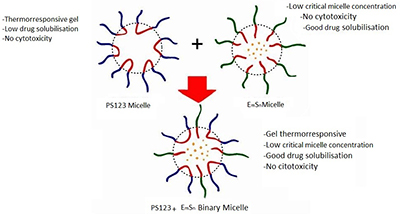
P123 and EmSn binary micelles presented thermorreversible gelation, low critical micelle concentration (cmc), good drug solubilisation capacity and no citotoxicity.
https://dx.doi.org/10.5935/0103-5053.20150205
J. Braz. Chem. Soc. 2015, 26(11), 2205-2213
Determination of Parabens in Surface Water from Mogi Guaçu River (Sao Paulo, Brazil) Using Dispersive Liquid-Liquid Microextraction Based on Low Density Solvent and LC-DAD
Carlos A. Galinaro; Fabiana M. Pereira; Eny M. Vieira
How to cite this article
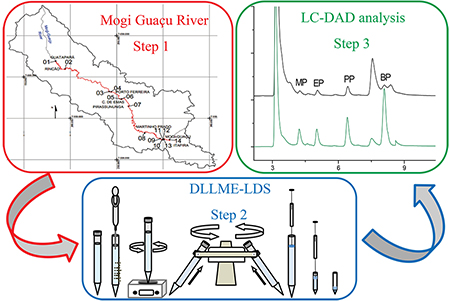
This study has demonstrated the successful analysis of parabens on surface water samples, collected from Mogi Guaçu River (Sao Paulo state, Brazil), by dispersive liquid-liquid microextraction (DLLME) based on low density solvent (LDS) combined with liquid chromatography with diode array detection (LC-DAD).
https://dx.doi.org/10.5935/0103-5053.20150206
J. Braz. Chem. Soc. 2015, 26(11), 2214-2223
Facile Method to Tune the Particle Size and Thermal Stability of Magnetite Nanoparticles
Loushambam H. Singh; Sudhanshu S. Pati; Maria J. A. Sales; Edi M. Guimaraes; Aderbal C. Oliveira; Vijayendra K. Garg
How to cite this article

Zeolite confines the growth of the magnetite nanoparticles and provides stability, which prevents from agglomeration and oxidation leading to structural transformation.
https://dx.doi.org/10.5935/0103-5053.20150207
J. Braz. Chem. Soc. 2015, 26(11), 2224-2232
Effects of Methyl-Substituted Phenanthrolines on the Performance of Ruthenium(II) Dye-Sensitizers
Andressa V. Müller; Poliana S. Mendonça; Stéphane Parant; Thibaut Duchanois; Philippe C. Gros; Marc Beley; André S. Polo
How to cite this article

Cis-[Ru(Me4-phen)(dcbH2)(NCS)2] was prepared, characterized and employed in dye-sensitized solar cells. The presence of four methyl groups on 1,10-phenanthroline modulates its ground and excited states and the ability to convert sunlight into electrical energy.
https://dx.doi.org/10.5935/0103-5053.20150208
J. Braz. Chem. Soc. 2015, 26(11), 2233-2240
Essential Oil from Flowers of Solanum stipulaceum: Composition, Effects of γ-Radiation, and Antileukemic Activity
Aura M. B. Osorio; Thiago M. Silva; Lucienir P. Duarte; Vany P. Ferraz; Márcio T. Pereira; Maria O. Mercadante-Simoes; Fernanda C. G. Evangelista; Adriano P. Sabino; Antônio F. C. Alcântara
How to cite this article
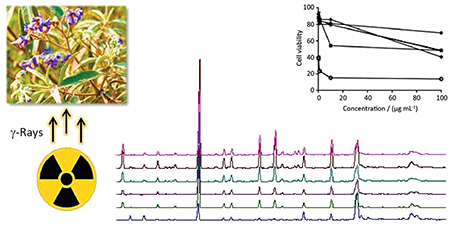
The essential oil composition of γ-irradiated flowers of Solanum stipulaceum was analyzed by gas chromatography (GC). The cytotoxicity of essential oils from non-irradiated and irradiated flowers was also studied.
https://dx.doi.org/10.5935/0103-5053.20150209
J. Braz. Chem. Soc. 2015, 26(11), 2241-2248
Discrimination of Annona muricata and Rollinia mucosa Extracts by Using Multivariate Curve Resolution and Partial Least-Squares Regression of Liquid Chromatography-Diode Array Data
Sabrina Afonso; Pablo L. Pisano; Fabiano B. Silva; Ieda S. Scaminio; Alejandro C. Olivieri
How to cite this article
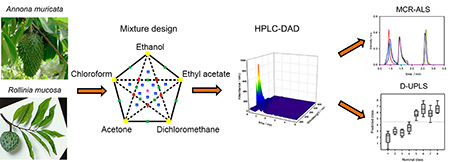
Discrimination of Annona muricata and Rollinia mucosa samples processed by multivariate curve resolution-alternating least-squares (MCR-ALS) and discriminant-unfolded partial least-squares (D-UPLS) of high-performance liquid chromatography with diode array detection (HPLC-DAD) data.
https://dx.doi.org/10.5935/0103-5053.20150210
J. Braz. Chem. Soc. 2015, 26(11), 2249-2257
Removal of Lead(II), Copper(II) and Zinc(II) Ions from Aqueous Solutions Using Magnetic Amine-Functionalized Mesoporous Silica Nanocomposites
Ali Mehdinia; Sahar Shegefti; Farzaneh Shemirani
How to cite this article
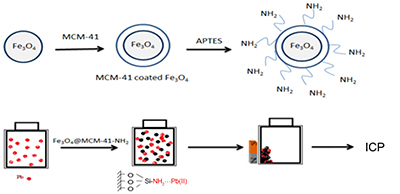
Fe3O4 nanoparticles were coated with mesoporous silica, MCM-41, and then amino-functionalization was performed on the MCM-41 surface by 3-aminopropyltriethoxysilane through the silanization reaction with hydroxyl groups of MCM-41. Fe3O4@MCM-41-NH2 was used for extraction of some toxic metal ions from aqueous solutions.
https://dx.doi.org/10.5935/0103-5053.20150211
J. Braz. Chem. Soc. 2015, 26(11), 2258-2268
Catalytic Activity of a Titanium(IV)/Iron(II) Heterometallic Alkoxide in the Ring-Opening Polymerization of ε-Caprolactone and rac-Lactide
Siddhartha O. K. Giese; Cristiano Egevardt; André Luis Rüdiger; Eduardo L. Sá; Thiago Alessandre Silva; Sônia F. Zawadzki; Jaísa F. Soares; Giovana G. Nunes
How to cite this article
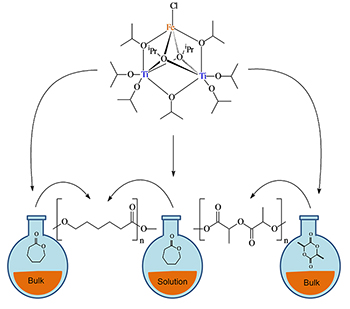
The heterometallic complex [FeCl{Ti2(OiPr)9}] was employed as initiator of ring-opening polymerization of ε-caprolactone and rac-lactide in bulk and in solution. The catalytic performance of the heterometallic complex was compared to the activities of other titanium(IV) and iron(II) complexes.
https://dx.doi.org/10.5935/0103-5053.20150214
J. Braz. Chem. Soc. 2015, 26(11), 2269-2278
Monitoring of Pesticide Residues in Surface and Subsurface Waters, Sediments, and Fish in Center-Pivot Irrigation Areas
Aderbal A. Rocha; Sérgio H. Monteiro; Graziela C. R. M. Andrade; Franz Z. Vilca; Valdemar L. Tornisielo
How to cite this article

This work is about a study of pesticide residue contamination in surface and subsurface waters, sediments and fish of center-pivot irrigation areas. Atrazine was observed below the method quantitation limit in subsurface water.
https://dx.doi.org/10.5935/0103-5053.20150215
J. Braz. Chem. Soc. 2015, 26(11), 2279-2289
Synthesis and Insecticidal Activity of Lactones Derived from Furan-2(5H)-one
Milena G. Teixeira; Elson S. Alvarenga; Mirian F. Pimentel; Marcelo C. Picanço
How to cite this article
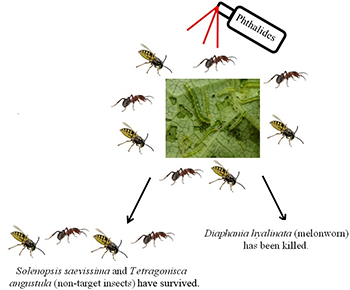
Besides the efficiency against insect pests, novel agrochemicals should preferably provide selectivity to non-target species. Therefore, the lactones synthetized in this work are promising as potential novel agrochemicals for the integrated pest management.
https://dx.doi.org/10.5935/0103-5053.20150217
J. Braz. Chem. Soc. 2015, 26(11), 2290-2297
Cinerascetins, New Peptides from Hypsiboas cinerascens: MALDI LIFT-TOF-MS/MS de novo Sequence and Imaging Analysis
Richardson A. Almeida; Marcelo Gordo; Felipe M. A. da Silva; Rafael C. de Araújo; Marcelo H. S. Ramada; Fernando Y. Abrao; Túlio O. G. Costa; Hector H. F. Koolen; Afonso D. L. de Souza; Carlos Bloch Jr
How to cite this article

In this work, new peptides named cinerascetins were identified from skin secretion of the Hypsiboas cinerascens. Imaging analysis localized the peptides on the dorsal tissue. Synthetic cinerascetin-01 was tested against some bacteria and fungi presenting satisfactory antimicrobial activities.
https://dx.doi.org/10.5935/0103-5053.20150219
J. Braz. Chem. Soc. 2015, 26(11), 2298-2306
Synthesis of 3-(1H-1,2,3-Triazol-1-yl)-2-(arylselanyl)pyridines by Copper-Catalyzed 1,3-Dipolar Cycloaddition of 2-(Arylselanyl)-3-azido-pyridines with Terminal Alkynes
Ricardo F. Schumacher; Patrick B. Von Laer; Eduardo S. Betin; Roberta Cargnelutti; Gelson Perin; Diego Alves
How to cite this article

The synthesis of 3-(1H-1,2,3-triazol-1-yl)-2-(arylselanyl)pyridines by copper-catalyzed cycloaddition reaction is presented here.
https://dx.doi.org/10.5935/0103-5053.20150221
J. Braz. Chem. Soc. 2015, 26(11), 2307-2312
Chemical Constituents of the Seeds of Raphanus sativus and their Biological Activity
Ki Hyun Kim; Eunjung Moon; Seoung Rak Lee; Kyoung Jin Park; Sun Yeou Kim; Sang Un Choi; Kang Ro Lee
How to cite this article
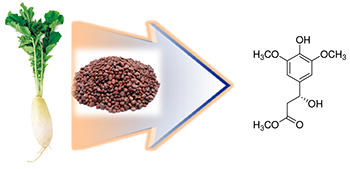
Fifteen constituents, including a new phenolic compound, were isolated from the seeds of Raphanus sativus. Some of the isolated compounds showed moderate antiproliferative activities and significant anti-neuroinflammatory effects.
https://dx.doi.org/10.5935/0103-5053.20150222
J. Braz. Chem. Soc. 2015, 26(11), 2313-2320
Electrosynthesis and Characterisation of Polymer Nanowires from Thiophene and its Oligomers
María Angelica del Valle; Andrea C. Ramos; Fernando R. Diaz; Manuel A. Gacitua
How to cite this article

Polythiophene was electrosynthesised as nanowires from the monomer and some of its oligomers on a Pt electrode previously modified with a template.
https://dx.doi.org/10.5935/0103-5053.20150223
J. Braz. Chem. Soc. 2015, 26(11), 2321-2330
Piperamides from Piper ottonoides by NMR and GC-MS Based Mixture Analysis
Thiago Wolff; Priscila F. P. Santos; Ligia M. M. Valente; Alvicler Magalhaes; Luzineide W. Tinoco; Rita C. A. Pereira; Elsie F. Guimaraes
How to cite this article
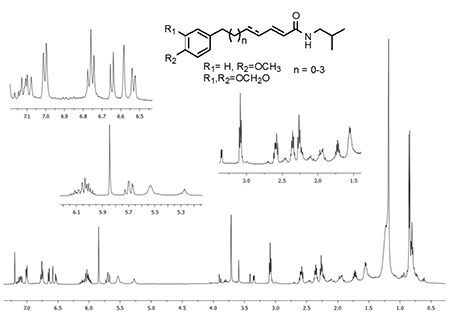
A new and five known piperamides were unequivocally characterized in mixture from few amounts of semi-purified fractions from fruits, leaves, stems and roots of Piper ottonoides by using nuclear magnetic resonance and gas chromatography-mass spectrometry.
https://dx.doi.org/10.5935/0103-5053.20150226
J. Braz. Chem. Soc. 2015, 26(11), 2331-2338
Evaluation of Monolithic and Core-Shell Columns for Separation of Triazine Herbicides by Reversed Phase High Performance Liquid Chromatography
Ricardo P. Urio; Jorge C. Masini
How to cite this article
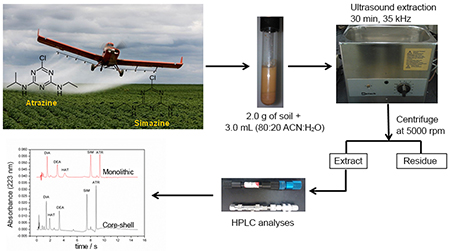
Monolithic and core-shell chromatographic columns were evaluated for separation of triazines and some of their metabolites in ultrasound extracted soil.
https://dx.doi.org/10.5935/0103-5053.20150227
J. Braz. Chem. Soc. 2015, 26(11), 2339-2345
Facile Microwave-Assisted Synthesis of Lanthanide Doped CaTiO3 Nanocrystals
Sandra C. Pereira; Alberthmeiry T. Figueiredo; Cristiano M. Barrado; Marcelo H. Stoppa; Yashashchandra Dwivedi; Maximo S. Li; Elson Longo
How to cite this article
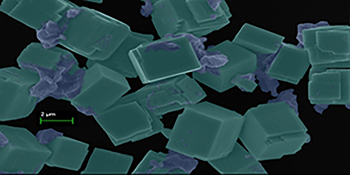
Fast synthesis of lanthanide doped CaTiO3 produces a microcube-like structure and a region without well-defined morphology. The structural disorder and observed photoluminescence emission are correlated.
https://dx.doi.org/10.5935/0103-5053.20150229
J. Braz. Chem. Soc. 2015, 26(11), 2346-2361
Synthesis, Structure Elucidation, Antioxidant and Antimicrobial Activity of Novel 2-(5-Trifluoromethyl-1H-pyrazol-1-yl)-5-(5-trihalomethyl-1H-pyrazol-1-yl-1-carbonyl)pyridines
Helio G. Bonacorso; Susiane Cavinatto; Maiara C. Moraes; Everton P. Pittaluga; Luis R. Peroza; Tarcieli Venturini; Sydney H. Alves; Sílvio T. Stefanello; Félix A. A. Soares; Marcos A. P. Martins; Nilo Zanatta; Clarissa P. Frizzo
How to cite this article

Synthesis, structure, antioxidant and antimicrobial activity evaluation of novel 2-(5-trifluoromethyl-1H-pyrazol-1-yl)-5-(5-trihalomethyl-1H-pyrazol-1-yl-1-carbonyl)pyridines bearing two distinct trihalomethyl substituted pyrazole rings.
https://dx.doi.org/10.5935/0103-5053.20150230
J. Braz. Chem. Soc. 2015, 26(11), 2362-2368
Mechanism of Hop-Derived Terpenes Oxidation in Beer
Natália E. C. de Almeida; Inara de Aguiar; Daniel R. Cardoso
How to cite this article

The oxidation of hop-derived terpenes in beer has been shown to occur through a hydrogen atom abstraction by 1-hydroxyethyl radical rather than by an electron transfer mechanism.
https://dx.doi.org/10.5935/0103-5053.20150231
J. Braz. Chem. Soc. 2015, 26(11), 2369-2378
Optimization of Parameters for Extraction of Avenanthramides from Oat (Avena sativa L.) Grain Using Response Surface Methodology (RSM)
Maria Maliarova; Viera Mrazova; Michaela Havrlentova; Jozef Sokol
How to cite this article
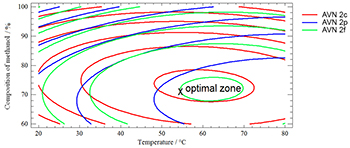
The optimization method which combined desirability function with response surface methodology (RSM) models was chosen to find the best extraction conditions for obtaining maximum yield of major avenanthramides from oat grain.
https://dx.doi.org/10.5935/0103-5053.20150233
Short Report J. Braz. Chem. Soc. 2015, 26(11), 2379-2383
Selective Oxidation of Amorphous Carbon by CO2 to Produce Fe@C Nanoparticles from Bulky Fe/C Matrices
Fernanda G. Mendonça; José D. Ardisson; Rochel M. Lago; Juliana C. Tristao
How to cite this article

Fe0 cores encapsulated in a carbon matrix treated with CO2 to selectively oxidize the amorphous carbon and release carbon coated magnetic nanoparticles.
https://dx.doi.org/10.5935/0103-5053.20150212
J. Braz. Chem. Soc. 2015, 26(11), 2384-2388
Spectrophotometric Determination of Aluminium in Hemodialysis Water
Eder J. Santos; Eduardo B. Fantin; Ronei E. Paixao; Amanda B. Herrmann; Ralph E. Sturgeon
How to cite this article
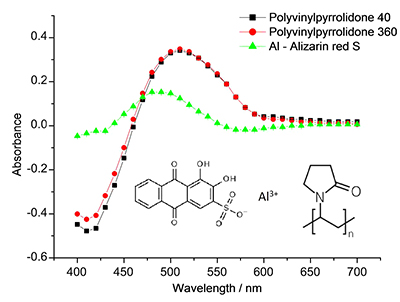
This work describes a simple and fast spectrophotometric method for the determination of aluminium in hemodialysis water employing alizarin red S in the presence of polyvinylpyrrolidone 40.
https://dx.doi.org/10.5935/0103-5053.20150224
Online version ISSN 1678-4790 Printed version ISSN 0103-5053
Journal of the Brazilian Chemical Society
JBCS Editorial and Publishing Office
University of Campinas - UNICAMP
13083-970 Campinas-SP, Brazil
Free access










